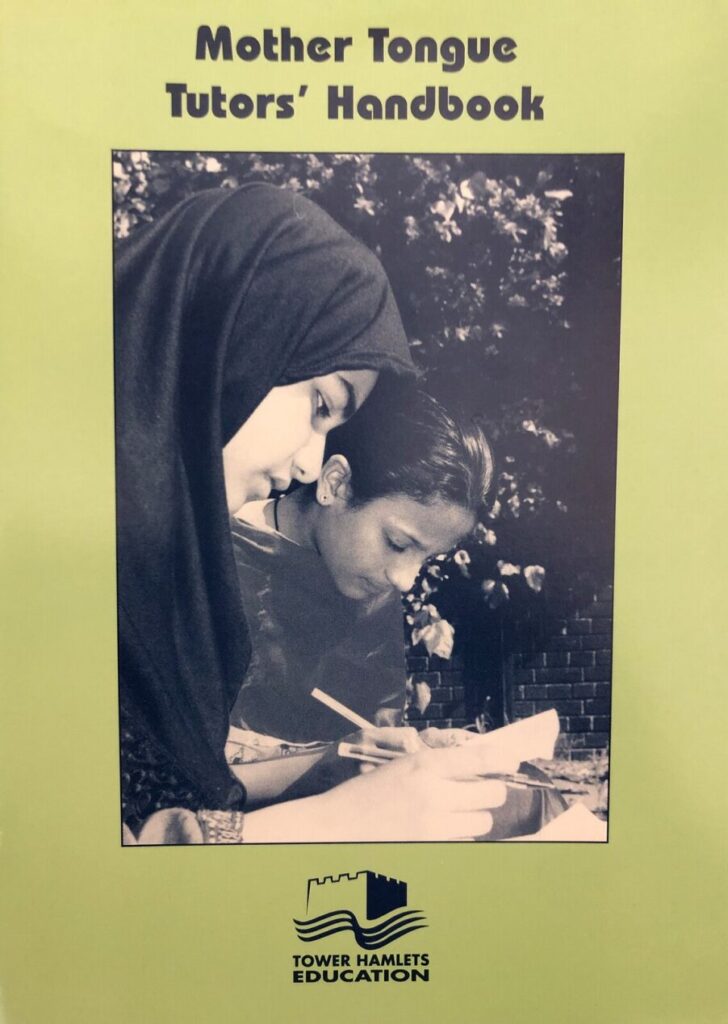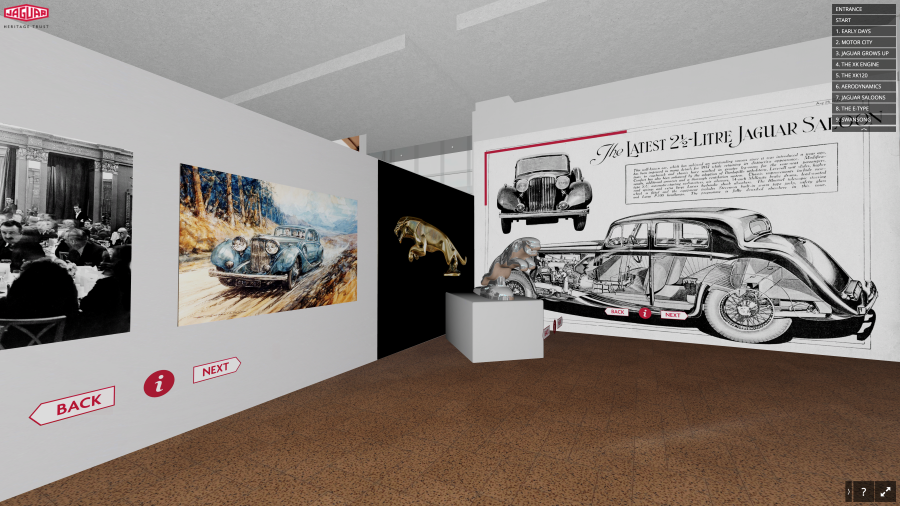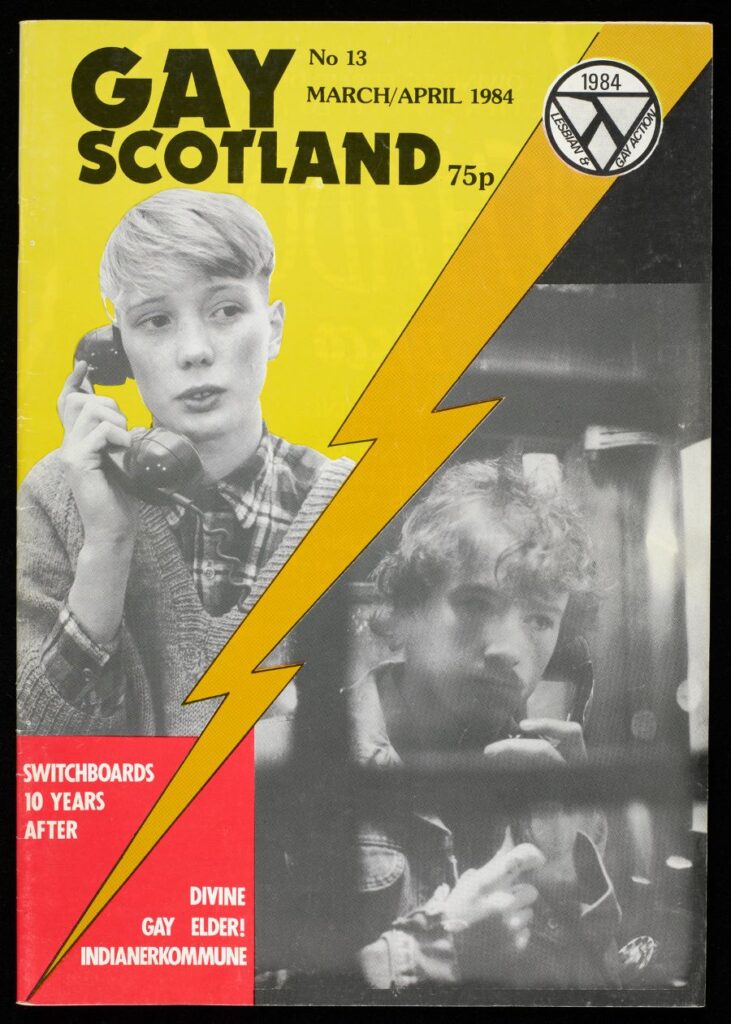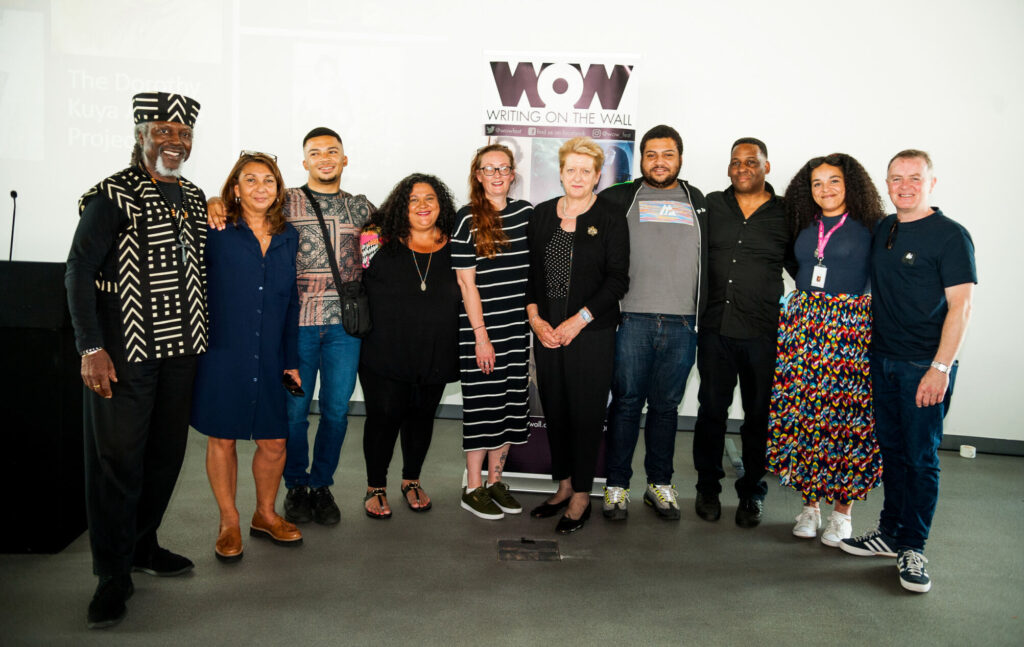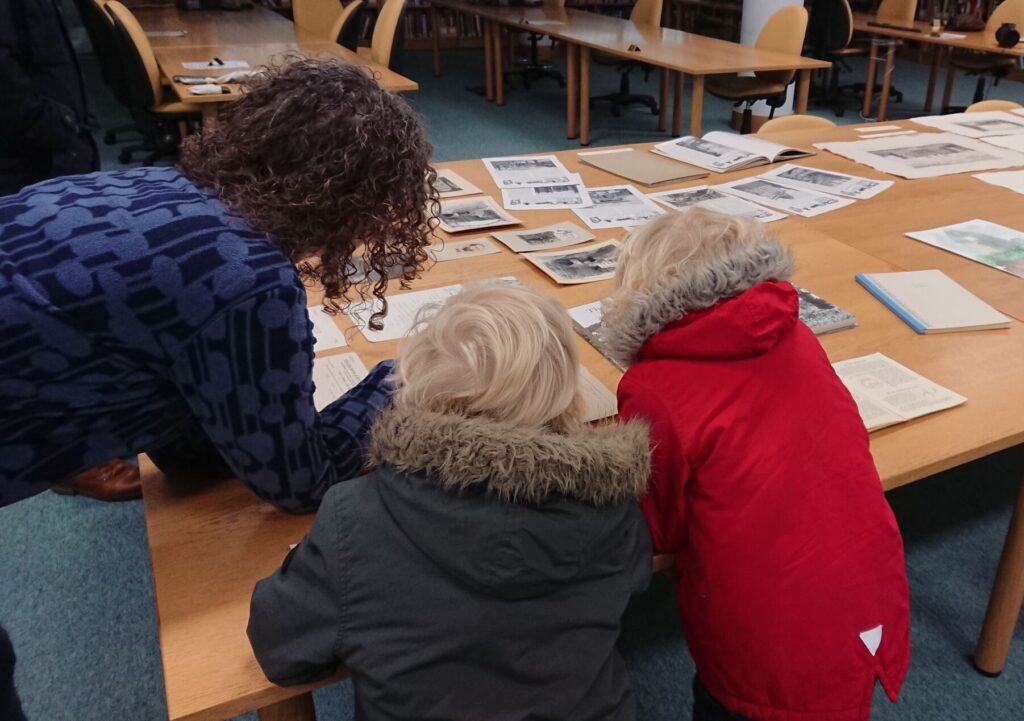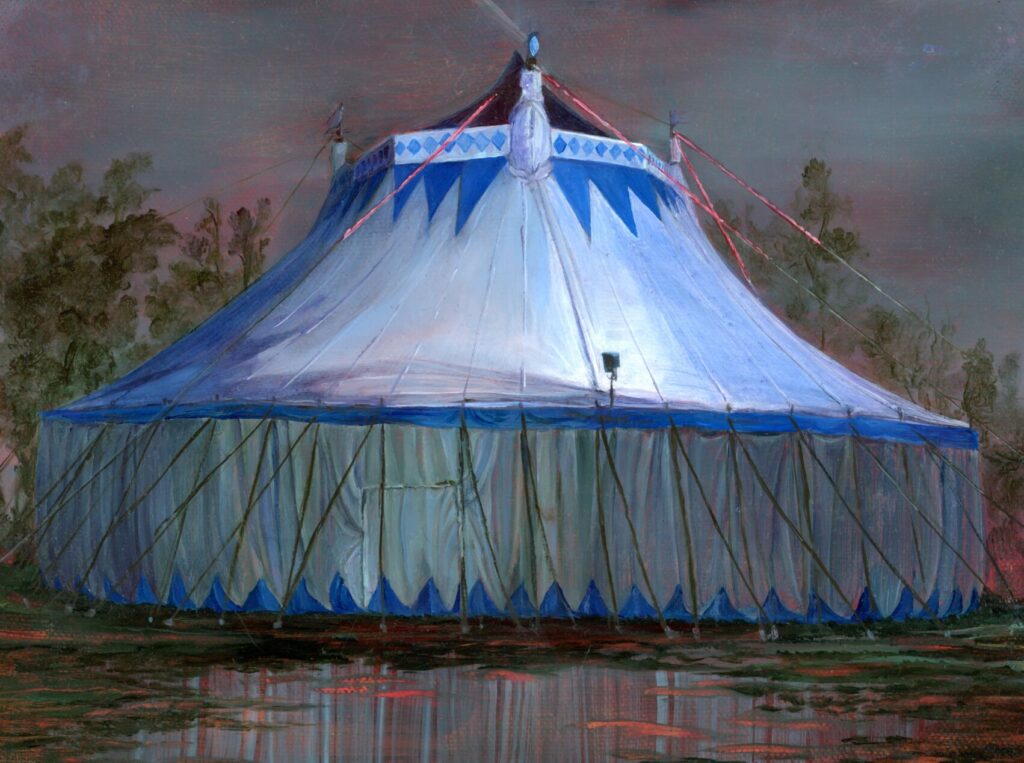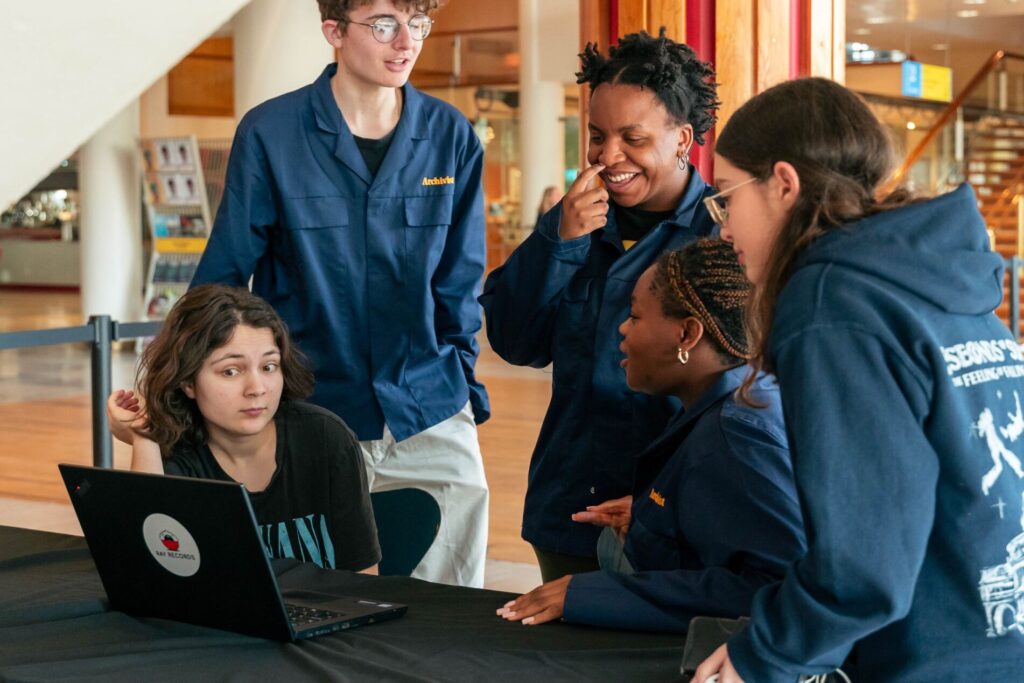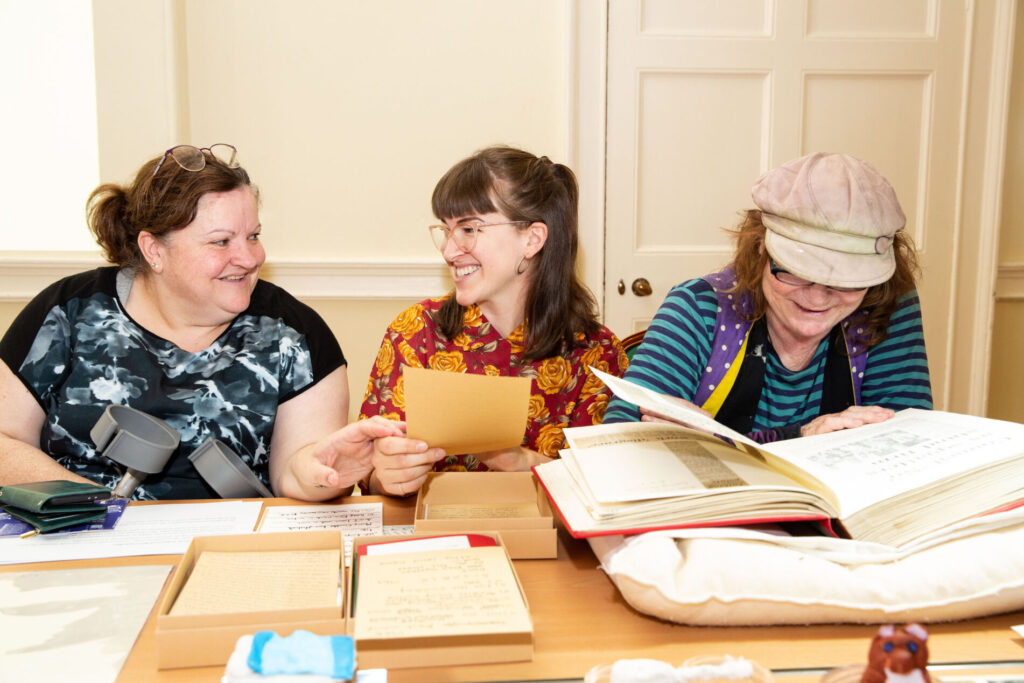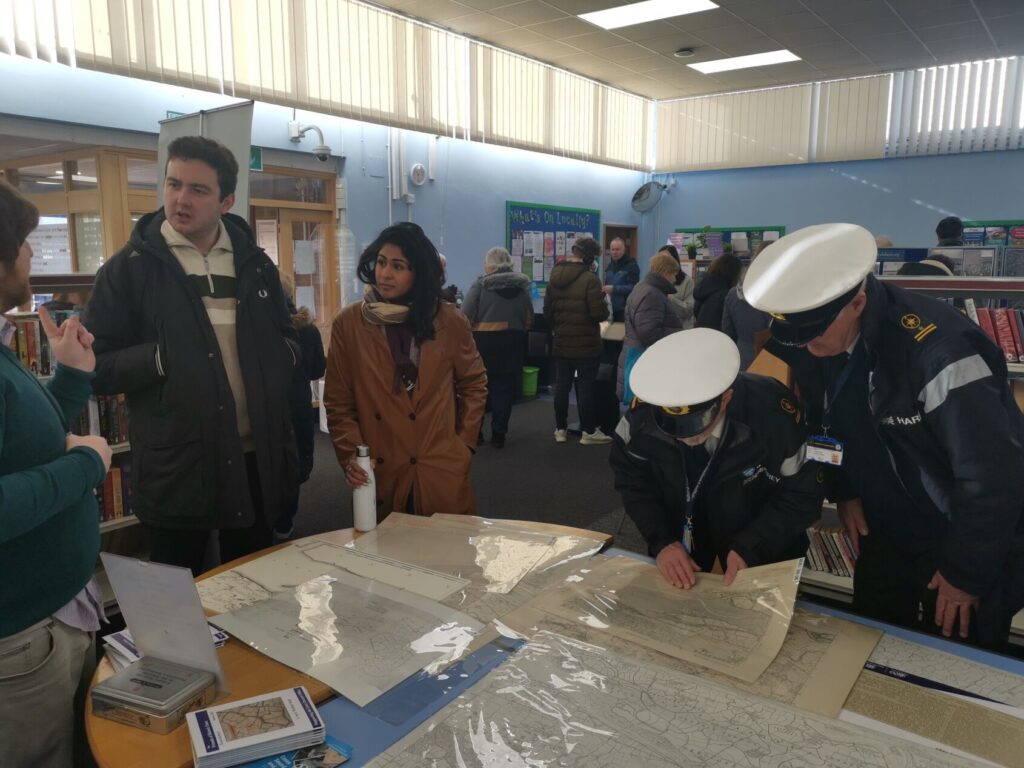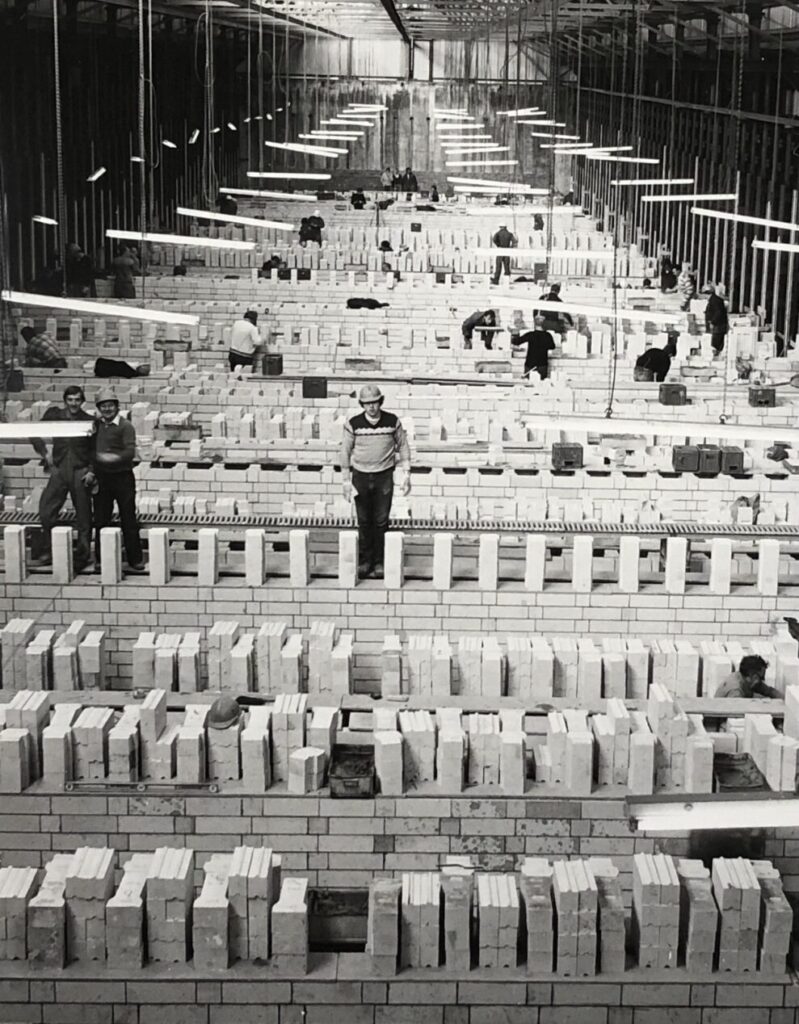Main section
Image credit (above): Writing on the Wall
Click on the headings below to read this year’s case studies, based on the themes of Archives Unlocked.
Tabs Navigation
Tabs
Advocacy and Reputation
“Liaising with colleagues in council teams as well as buddying with Facilities Management and Logistics staff were crucial to the success of the project.”
Richard Wiltshire
Archive Manager, Tower Hamlets Local History Library and Archives
An eighteen-month project saw the large-scale transfer of archives from Tower Hamlets Town Hall at Mulberry Place, near London Docklands, to Tower Hamlets Local History Library and Archives at Bancroft Road. The Mulberry Place site in East London had been the council headquarters of the London Borough of Tower Hamlets since 1993. Seven floors housed the records of many teams, including Town Hall Planning, Youth Services, Public Health, Educational Psychology, School Buildings, Governors’ Services and Democratic Services. The transfer of archives was a necessary part of the move of all council services to the new Town Hall in Whitechapel, which was designed on the principle of zero hardcopy records storage.
During 2021, the Archive Manager and Heritage Officers gave presentations to directors of the five directorates: Children and Culture, Governance, Place, Resources and Health, Adults and Community to advocate the importance of preserving council records. This resulted in the official endorsement of the selection and transfer of records. Senior managers also gave approval for the project team to cascade information linking to guidance on the intranet.
The archive team issued guidance to Town Hall staff on what records to look out for, referring to existing retention schedules. The team then made floor walks around Mulberry Place with members of Facilities Management to talk with staff to learn more about what material existed and explain the process of transferring historical records. On subsequent Town Hall, visits support was provided to departments such as Public Health, which had extensive records stored on rolling racks. Updates were also posted on internal social networking site Yammer.
From February 2022 to February 2023, the archive team spent a total of 132.5 hours surveying records at the Town Hall. Team members compiled a spreadsheet to track the location of the records and to monitor progress as they moved and accessioned records into the online cataloguing system, CALM.
The archive team transferred over eighty individual collections to the archive stores, including a fantastic range of photographs, council minutes and exhibition displays. Some highlights included the predecessor records of the council, such as the Metropolitan Borough of Poplar register of property from the 1900s, deeds dating back to the 1800s and records of Tower Hamlets Unison staff union with cartoons and images from 1970s.
Other highlights were records relating to services for the local Bengali community such as the Community Language Service, and the file of one of the Mile End Stadium managers with photographs of the 1995 Blur concert. The archives which were acquired between February 2022 and February 2023 extend to 82 linear metres, which – compared with the 53 linear metres of material acquired in 2019-21 – represents an increase on the monthly rate of accrual of over 270%.
Digital
“We have one of the world’s greatest car collections, but no museum of our own, so it seemed appropriate to launch a virtual museum that will be accessible to all”.
Matthew Davis,
Former Managing Director of Jaguar Daimler Heritage Trust (JDHT)
With Jaguar Cars’ centenary approaching, there was ambition to use the company archives to reach new audiences. Since no physical exhibition space was available, the Jaguar Daimler Heritage Trust (JDHT) pushed boundaries by working with Painting the Cave, a specialist in creative digital technologies, to create a game-like exhibition experience that is accessible across multiple devices and will be available for years to come. This collaboration led to a carefully curated virtual display that provides an authentic and engaging interpretation of Jaguar’s founder Sir William Lyons’ life and designs.
The virtual exhibition harnessed the power of first-person gaming technology to create an interactive and user-led online experience for visitors. From their own device, visitors can ‘walk’ past displays of previously unseen archival images and film footage, choosing which areas to view, when, and from where in the exhibition space, just like an in-person exhibition.
To coincide with the centenary year, the JDHT recruited an Archive Assistant Apprentice, funded by the Sir William Lyons Foundation, continuing the Jaguar tradition of investing in the education of the local community. The Archive also began cataloguing its largest collection, the Sir William Lyons Collection, to ISAD(G) standards, which will fully open this significant collection to researchers for the first time. Another project in progress is the creation of a virtual reading room to make more archive material accessible to researchers who cannot visit the JDHT in person.
The projects have been successful on many levels. Additional benefits include longer availability and greater reach than would have been possible with a physical exhibition, with visitors from over 137 countries (according to IP addresses) spending an average time of 38 minutes in the online exhibition. Additionally, new virtual exhibitions will benefit from the initial investment in the infrastructure and the knowledge and skills that the team have developed as part of this project.
Diversity and Inclusion
“The highlight of this project was being able to engage local LGBTQ+ groups with the history of their community, many of whom were in contact with archives for the first time.”
Louise Neilson
Access Officer, Lothian Health Services Archive
For the first time, Lothian Health Services Archive (LHSA) has provided access to the Lothian Gay and Lesbian Switchboard (LGLS) collection through its project ‘Speaking Out’. Established in 1974, LGLS was the first helpline in the UK (and charity in Scotland) to provide mental and physical health support to the LGBTQ+ community.
LHSA received Wellcome Trust funding to catalogue and re-house the collection, which had been previously closed to the public. The collection includes almost 5000 individual call cards, containing personal data about LGLS’s volunteers and callers. The ‘Speaking Out’ project archivist created anonymised transcripts and summaries to allow LHSA to manage access requests from researchers within data protection legislation.
Further funding from the Scottish Public Engagement Network enabled LHSA to run a series of creative writing and zine-making workshops to engage the local queer community with the LGLS collection. Tapping into pre-existing community networks, including LGBT Youth Scotland and LGBT Health and Wellbeing’s ‘LGBT Age’ project, the workshops included participants ranging from 13 to over 50 years of age.
The participants’ creative outputs were subsequently developed into a digital exhibition containing images of records, writing, drawings and videos. These outputs showcased how participants explored themes related to the collection, such as ‘Safe Space/Queer Space’, ‘Protest and Resistance’ and ‘Animals’. Once the digital exhibition went live, the workshops were fine-tuned and re-opened for the public to attend.
‘Speaking Out’ has received extensive engagement and an excellent response from participants. Articles and blog posts published by LGBT Health and Wellbeing highlight the positive personal impact for older participants, of both intergenerational collaboration and connecting with other members of the local queer community. The workshops also proved to be a learning experience for LHSA colleagues, who hope to maintain the strong relationships they have developed with these community networks through future engagement.
Enrichment
“Communities are at the centre of WoW’s Creative Heritage model. Affording people ownership of their own heritage, who determine, through various creative responses how their own histories are told.”
Madeline Heneghan
Writing On The Wall
“We had a fantastic group of volunteers, whose energy and enthusiasm were key to the success of the Dorothy Kuya archives project.”
Vicki Caren
National Museums Liverpool
In 2022 National Museums Liverpool commissioned Writing on the Wall (WoW) to deliver The Dorothy Kuya Creative Archives Project. Born in the 1930s in the era of the Great Depression, Dorothy Kuya was a lifelong Black British activist, who championed anti-racist, anti-sexist and anti-colonial causes in Liverpool and London.
Using WoW’s successful creative heritage model, the project aimed to catalogue Dorothy’s papers and personal library, as well as raising her profile locally and nationally The project ran for nine months and included a 20-week programme to upskill community volunteers. The first 4 weeks focused on research into Dorothy’s life. This was followed by 12 weeks working with the archive material and the final weeks of the project provided an opportunity to work with a local artist to create artwork and imagery based on elements of Dorothy’s life.
WoW published a series of blog posts written by project staff to keep audiences up to date with discoveries from the Dorothy Kuya archive. In addition, a podcast was produced in association with local internet radio station Melodic Distraction. All five episodes of the podcast focused on a specific time period, putting Dorothy’s life into social and political context. Both the blog and podcast are available on WoW’s website.
As Dorothy was an active member of the National Assembly of Women, staff and volunteers were inspired to organise an event in celebration of International Women’s Day in March. The event included a ‘living library’, which showcased local black women from diverse sectors sharing insights into their work and achievements. There was also a zine-making workshop and a pop-up feminist library from Dorothy’s own collection.
As part of WoW’s annual festival in May, a smaller group designed and delivered a walking tour, which focused on different facets of Dorothy’s life and work.
At the end of July 2023, a project celebration was held at the Museum of Liverpool. Over 70 people attended including Dorothy’s family and friends. Sharon Grant, widow of MP Bernie Grant, spoke about Dorothy’s campaigning work with Bernie in Haringey, London, and members of her local community shared their memories of Dorothy.
Health and Wellbeing
“It helped link up history we have learned about as a part of our home education, and linking it to places we live near or pass in our day-to-day life”
Home Education participant
In Spring 2022 the Wiltshire & Swindon History Centre began working with Rooted, a CIO, to create a community garden within the grounds of the Centre. The aim was to encourage the local community to grow vegetables, eat healthily and get involved with gardening for a positive impact on physical and mental wellbeing.
The Centre secured a £10,000 Archive Testbed grant from The National Archives. A range of activities were created using archive collections, relating to gardens and gardening. Some activities dovetailed with the launch of the 1921 census and especially featured 1920s gardens and planting schemes. Using the 1920s as a focal point provided a pathway for participants to explore associated archives material of the period, such as newspapers, photographs, letters, maps and estate records. This element of the project aimed to provide a direct point of inspiration for those involved, to engage them with gardening and the archive.
Talks and workshops were popular on historic gardening and there were helpful leaflets and online information on growing heritage vegetables. One of the standout successes was the ‘starter garden’ packets of heritage seeds, which were provided alongside links to the archive through photographs and historical information This concept could be used in the future to spotlight specific documents or collections.
Involvement with the community garden and with the archive sources facilitated engagement by individuals on their own or as part of a group. These activities were not targeted at specific groups or communities – the aim was to stimulate a wider, more informal approach to physical and well-being activity for all ages and abilities. However, one group the project enabled engagement with was home educating families, and this was an unexpected but very positive outcome of the project which has allowed a link to this group for the future.
Wiltshire Council have invested in the site, providing poly tunnels, compost bins and equipment. The community garden runs itself and every other Saturday the gardening group comes along. However, it’s an open site and everyone is encouraged to come in and pick the produce!
Impact
“There are these little legacies that are unfurling, it keeps giving”
Joanna Whittle
Landscape Artist
The National Fairground and Circus Archive (NFCA) collaborated with landscape artist Joanna Whittle in a year-long project that resulted in her producing artworks in response to the collection and an exhibition of this work, Ghosted Ground, at Sheffield University.
Joanna’s artworks, exploring themes of presence and absence, transience and loss, appeared in the exhibition alongside items from the collection that inspired her. Crucially, the exhibition also gave equal prominence to items collected during the project, including oral histories, photographs, and films, some of which are now part of the wider NFCA collection. Joanna and the NFCA gathered these as they explored the existing collection alongside individuals, families, and groups from Showmen*, circus and performing communities who travel and work across the country today, as well as a range of other collaborators, including fellow artists, local youth group Society of Explorers, and members of the theatre company The Big House.
Engagement was built into the project from the start. Joanna invited others into the archive and took copies of archival material out to communities, such as the Showmen attending the annual King’s Lynn Mart. This fostered shared experiences and aimed to dismantle barriers to access and belonging often associated with archives. It also challenged preconceived notions of how university-based archives can and should be used, emphasising creative responses rather than focusing on traditional academic research outputs.
Joanna and the NFCA also linked individuals and groups with one another throughout the year, with the project providing the impetus for future collaborations, such as between photographer Bob Chase and Showman and PhD student Sheldon Chadwick, founder of the Showmen’s Mental Health Awareness Charity. This ripple effect is one that they aim to replicate in their next joint project.
Ghosted Ground has cemented the NFCA’s relationship with Joanna and strengthened its relationship with the communities whose archives it holds. For Joanna, the stories she encountered in the archives will continue to inform her practice. An online version of the exhibition is planned, meaning there will be a wider audience for what Joanna has termed this ‘generous conversation’ between archives, the culture of Showmen, circus and performing communities, and art.
*The word Showman/Showmen is used to refer to men, women and children from the British fairground community as the preferred term used by a large section of this community to refer to themselves.
Innovation and Risk
‘We have a history of co-curation projects in the Archive Studio but, before now, these have always been artist or creator-led.’
Clare Wood, Archivist
Southbank Centre
Southbank Centre Archives delivered a course for young people called Future Exhibition Makers. This was a collaboration between the Archive team and the Creative Engagement team at the Southbank Centre – the first time that the two teams had worked so closely together. It was one of three strands in the Southbank Centre’s curatorial development scheme, funded by the Rothschild Foundation, to support workforce development across the creative industries.
Sixteen London-based participants aged 13-18 were recruited via call-outs to schools, charities, youth organisations and other partners, and through paid advertisements on Instagram, Facebook, Twitter and TikTok. Throughout March 2023 participants gained an understanding of archives, curation and exhibition-making through a mix of in-person and online events.
Course content was developed with expert freelancers and shaped by a diverse range of guest speakers and institutions. 2023 marks the 40th anniversary of Southbank Centre’s Open Foyer policy, which enables free, all-day access to events and exhibitions hosted in the foyer of the Royal Festival Hall. Archive planning files from the 1980s foyer exhibition programme formed the basis of the curation and exhibition work.
Despite an intensive course schedule, which participants had to balance with academic and family responsibilities, the programme saw excellent engagement and attendance. The project outputs included physical and digital exhibitions – the content of which was selected and curated solely by the participants – and a social media takeover of the Southbank Centre’s Instagram stories.
The project culminated in an exhibition launch event attended by the the participants’ families and friends and industry professionals. Participants even curated a Spotify playlist of 1980s tracks to play at the launch! Future Exhibition Makers has enabled internal and external promotion of the archive, re-ignited partnerships with external stakeholders, and equipped a group of young people with skills and experience of working in the creative industries.
Resilience
“The records have been able to inspire some creative responses from participants in light of their own experiences of housing.”
Kevin Guy,
Leader of Bath & North East Somerset Council
Funded by the Wellcome Trust, Bath Record Office: Archives and Local Studies ran the engagement project ‘Imagine: 100 Years of Housing in Bath’ with two community groups – Get Creative and Genesis Trust. The project involved a series of creative workshops co-facilitated by archives staff and artist Ellie Shipman. Local residents – many of whom had been affected by housing issues – had the opportunity to engage with Bath’s housing archive and explore different art techniques as a way to wellbeing.
A wide range of archival material was used as inspiration: from architectural plans, maps and newspaper clippings to resident complaint letters, old keys and photographs of home interiors. They used these to consider how housing has changed and how housing can affect someone’s health.
The participants discussed their own experiences in relation to the records and shared objects that meant ‘home’ to them. The participants also produced a variety of creative outputs from poetry and map-making to clay modelling and digital drawing. The material and topics resonated with the participants and had a positive effect on their wellbeing.
Across the six sessions, each participant created their own archive box which they donated to Bath Record Office, bringing previously unheard local voices, perspectives, and knowledge into the archive. Participants enjoyed adding to the city’s official record for future generations to learn from and these contemporary additions will make the archive even more relevant and representative.
The project culminated in a one-day exhibition at Bath’s Guildhall, attended by councillors and the Mayor. The event showcased to senior council staff (including housing colleagues) how archives can inspire artistic works and can be a key engagement resource for the Council, providing social, historical and personal value.
The project improved the team’s confidence and engagement skills and has inspired Bath Record Office to seek new and dynamic ways of using the collections to engage its audiences. Good relations with community groups were vital to broadening the archive’s audience and the team hopes to continue to build on these relationships. Since meaningful and successful community engagement work requires planning and capacity, Bath Record Office is now exploring how they can integrate this work in a sustainable way into their core activity.
Openness
“We were struck by the strong community identity. Many people told us how pleased they were that we had made the effort to reach out and help mark the occasion.”
Martin Astell
Essex Record Office Manager
Earlier this year, Essex Record Office (ERO) commemorated the 70th anniversary of the 1953 east coast floods, a disaster which claimed 120 lives in Essex. The starting point of their commemoration was a reprinting of ‘The Great Tide’, by Hilda Grieve – then Senior Assistant Archivist at the Essex Record Office – which documented the ‘complete story’ of the disaster. Ideas for the commemoration started in 2020 but, as with many things during the pandemic, ERO staff had to shelve plans for a couple of years to release the book, described by writer and social historian, Ken Worpole as ‘one of the great works of 20th century English social history’. When it became possible to start making plans again, the 70th anniversary of the flood was fast approaching, so ERO needed to work quickly and effectively in collaboration with others.
This collaborative effort involved community groups, the Environment Agency and National Coastwatch. Public events at Canvey Island Library and Harwich Museum invited people to view displays of maps detailing the extent of the damage, as well as audio and video content, including a video montage of contemporary footage. Local primary schools were invited to attend these events and talk with the community archives team to learn more, while teaching packs were also sent to local schools. Visitors to the events even included people who had experienced the flood first-hand as young children, bringing authentic original accounts of the disaster. In total, around 1,700 people were engaged in the commemoration.
Trust
“The Teesworks project has been great for the service. Although it was challenging, it has done wonders to help raise our profile as well as engage new people, and save an important collection.”
Ruth Hobbins
Archives Manager, Teesside Archives
The Redcar Steelworks was a major employer in the Redcar and Middlesbrough area, as well as providing and prominent visual landmarks. After a period of decline, the core of the site was closed in 2015, leading to the loss of many jobs. Initial attempts by Teesside Archives to negotiate a deposit of records from the site were unsuccessful.
Subsequently, staff from the archives built links with the local Save Our Steel Heritage group, a coalition of local councillors, former workers and academics interested in sensitive redevelopment of the site, and also with staff at the new Tees Valley Combined Authority, who had heritage and culture responsibilities.
By July 2021, access to the site was highly restricted on health and safety grounds as demolition work was underway. However, as a result of the relationship-building, the Archives Manager and Conservator were invited to view the surviving archives, including plans and photographic negatives, correspondence files, publications and operational records. These were located in a former canteen, piled on the floor, and also in large filing cabinets in a semi-derelict building.
The Tees Valley Combined Authority paid much of the costs of the project to save the records, which involved removals, a freelance project officer, packaging materials, a consultant to carry out the oral history interviews, and website development.
This all happened at the tail end of the COVID-19 pandemic, and while Teesside Archives were moving to temporary premises at the Dorman Museum in Middlesbrough. The archives from the steelworks were therefore transported to a temporary warehouse for sorting and cataloguing.
As a result of the project, Teesside Archives have selected, catalogued and repackaged hundreds of plans. The community have made additional related deposits and people have contributed oral histories to enhance knowledge of the steelworks. The project cataloguer and the archivist presented a paper on the project at an academic conference in Sheffield. A website is also under development, which will showcase the history of the site, including 3D models.
Trust was central to the project in several ways and was the result of years of work carefully developing relationships. It enabled staff to gain access to the collection and have it deposited, and to engage the local community. Trust enabled the archive staff to avoid having to take sides in sometimes fraught local politics surrounding the future of the site.
